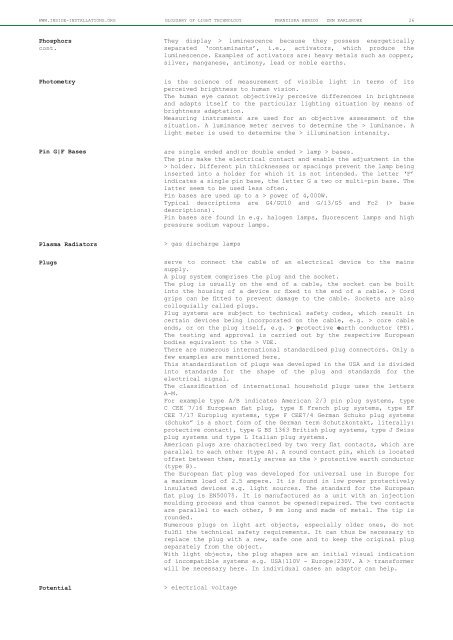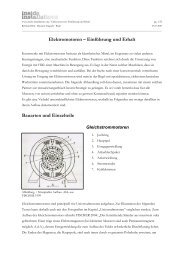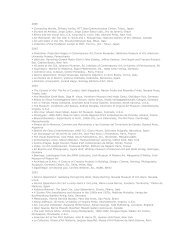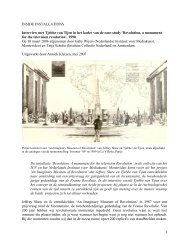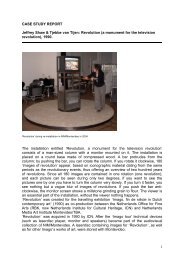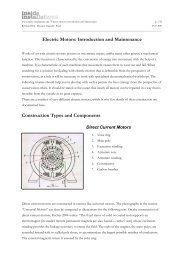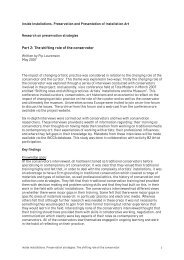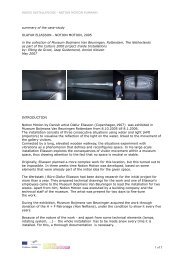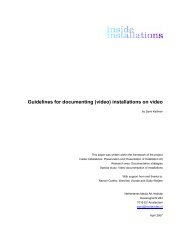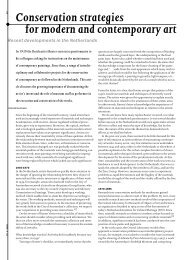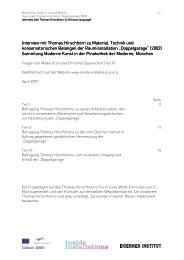GLOSSARY OF LIGHT TECHNOLOGY - Inside Installations
GLOSSARY OF LIGHT TECHNOLOGY - Inside Installations
GLOSSARY OF LIGHT TECHNOLOGY - Inside Installations
Create successful ePaper yourself
Turn your PDF publications into a flip-book with our unique Google optimized e-Paper software.
WWW.INSIDE-INSTALLATIONS.ORG <strong>GLOSSARY</strong> <strong>OF</strong> <strong>LIGHT</strong> <strong>TECHNOLOGY</strong> FRANZISKA HERZOG ZKM KARLSRUHE 26<br />
Phosphors<br />
cont.<br />
Photometry<br />
Pin G|F Bases<br />
Plasma Radiators<br />
Plugs<br />
Potential<br />
They display > luminescence because they possess energetically<br />
separated ‘contaminants’, i.e., activators, which produce the<br />
luminescence. Examples of activators are: heavy metals such as copper,<br />
silver, manganese, antimony, lead or noble earths.<br />
is the science of measurement of visible light in terms of its<br />
perceived brightness to human vision.<br />
The human eye cannot objectively perceive differences in brightness<br />
and adapts itself to the particular lighting situation by means of<br />
brightness adaptation.<br />
Measuring instruments are used for an objective assessment of the<br />
situation. A luminance meter serves to determine the > luminance. A<br />
light meter is used to determine the > illumination intensity.<br />
are single ended and|or double ended > lamp > bases.<br />
The pins make the electrical contact and enable the adjustment in the<br />
> holder. Different pin thicknesses or spacings prevent the lamp being<br />
inserted into a holder for which it is not intended. The letter ‘F’<br />
indicates a single pin base, the letter G a two or multi-pin base. The<br />
latter seem to be used less often.<br />
Pin bases are used up to a > power of 4,000W.<br />
Typical descriptions are G4/GU10 and G/13/G5 and Fc2 (> base<br />
descriptions).<br />
Pin bases are found in e.g. halogen lamps, fluorescent lamps and high<br />
pressure sodium vapour lamps.<br />
> gas discharge lamps<br />
serve to connect the cable of an electrical device to the mains<br />
supply.<br />
A plug system comprises the plug and the socket.<br />
The plug is usually on the end of a cable, the socket can be built<br />
into the housing of a device or fixed to the end of a cable. > Cord<br />
grips can be fitted to prevent damage to the cable. Sockets are also<br />
colloquially called plugs.<br />
Plug systems are subject to technical safety codes, which result in<br />
certain devices being incorporated on the cable, e.g. > core cable<br />
ends, or on the plug itself, e.g. > protective earth conductor (PE).<br />
The testing and approval is carried out by the respective European<br />
bodies equivalent to the > VDE.<br />
There are numerous international standardised plug connectors. Only a<br />
few examples are mentioned here.<br />
This standardisation of plugs was developed in the USA and is divided<br />
into standards for the shape of the plug and standards for the<br />
electrical signal.<br />
The classification of international household plugs uses the letters<br />
A-M.<br />
For example type A/B indicates American 2/3 pin plug systems, type<br />
C CEE 7/16 European flat plug, type E French plug systems, type EF<br />
CEE 7/17 Europlug systems, type F CEE7/4 German Schuko plug systems<br />
(Schuko” is a short form of the German term Schutzkontakt, literally:<br />
protective contact), type G BS 1363 British plug systems, type J Swiss<br />
plug systems und type L Italian plug systems.<br />
American plugs are characterised by two very flat contacts, which are<br />
parallel to each other (type A). A round contact pin, which is located<br />
offset between them, mostly serves as the > protective earth conductor<br />
(type B).<br />
The European flat plug was developed for universal use in Europe for<br />
a maximum load of 2.5 ampere. It is found in low power protectively<br />
insulated devices e.g. light sources. The standard for the European<br />
flat plug is EN50075. It is manufactured as a unit with an injection<br />
moulding process and thus cannot be opened|repaired. The two contacts<br />
are parallel to each other, 9 mm long and made of metal. The tip is<br />
rounded.<br />
Numerous plugs on light art objects, especially older ones, do not<br />
fulfil the technical safety requirements. It can thus be necessary to<br />
replace the plug with a new, safe one and to keep the original plug<br />
separately from the object.<br />
With light objects, the plug shapes are an initial visual indication<br />
of incompatible systems e.g. USA|110V - Europe|230V. A > transformer<br />
will be necessary here. In individual cases an adaptor can help.<br />
> electrical voltage


